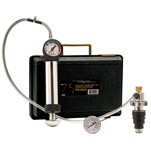Blog
Testing a cooling system
Using the Cooling System Test Kit
Cautionary Note: Do not attempt to remove a radiator cap on a hot vehicle. To avoid personal injury, always allow the vehicle to cool down sufficiently.
In general, seasonal weather changes cause more malfunctions in the cooling system of an average vehicle, but things can and do wrong at any time. Usually, changes in temperature and barometric pressure affect the seals and hoses in the system, causing several types of problems. If your place enjoys seasonal changes, you should have your vehicle's cooling system checked by a repair shop once in late spring and then again in early fall. Alternately, check the cooling system visually once a year – inspect the hoses, the water pump area and look for visible signs of leakage.
Normally, such visual signs will include rust, orange or green, depending on the type of coolant used. These will usually be in the form of 'trails' streaming down from where the leak exists. Sometimes, leaks will only occur after the system has run for a while and come up to the full operating temperature. At other times, some leaks will appear only after you have shut down the system and the vehicle has cooled off. Therefore, check the system for leaks in both conditions.
What Is The Function Of A Cooling System?
All vehicles need a cooling system to maintain their operating temperature to a safe level. Excessive heat builds up in the engine during the combustion process in its cylinders and some method is required to remove this heat. One of two methods is used to remove excessive heat – by circulating air around the engine cylinders or by circulating a coolant/water mixture around the cylinders inside an engine block. In general, manufacturers prefer a liquid filled engine cooling system.
What Are The Other Parts Of A Cooling System And How Do They Function?
Typically, an engine cooling system utilizes the radiator, fans, fan clutch and belt, water pump, gaskets, engine block and heads, thermostat, hoses and the heater core. The fans and the radiator remove excessive heat from the engine by circulating the coolant through a series of hoses to hold the temperature constant. Excessive temperatures could damage the engine permanently.
What Are The Tests To Check The Performance Of The Cooling System?

There are several tests that cover a broad area. You will require a cooling system pressure test kit for conducting these tests.
Pressure Test: You apply pressure on the cooling system with the test kit. It simulates the running condition of the entire cooling system and places pressure on the gaskets, seals and hoses throughout the system to detect leaks.
Temperature Test: The test kit has a temperature probe, which you can use to measure if the live system temperature is within the acceptable range. It will indicate whether the engine is running at the proper temperature or if it is too cold or too hot.
You can monitor the actual operation of the cooling system thermostat as it opens and closes as it regulates the liquid flow through the cooling system. The manufacturer and parts suppliers would have published data for your vehicle and its proper thermostat temperature. Do not use a 'cooler' or a 'hotter' thermostat than what the manufacturer recommends. The onboard computer of the vehicle monitors the temperature of the engine very closely for ensuring that the engine uses the most ideal air/fuel mixture.
Coolant Concentration Test: There are different ways to perform this test. You can use alkaline test strips, a refractometer or a hydrometer, the last being the most common. This test indicates if the balance of water and coolant in your system is the most optimum. Although a water/coolant mixture in most cases is typically 50/50, some manufacturers also recommend 40 parts of water to 60 parts of coolant in the system. While a system with 100% coolant is not recommended as the coolant by itself will not dissipate the heat quickly enough, 100% water is also bad for the system as it will create corrosion problems along with poor heat dissipation.
Pressure Cap Test: Two basic cap tests that you can perform are the pressure and vacuum tests. The pressure test will indicate at what point the cap starts to yield under pressure and this should match with what is printed on the cap. There is a dedicated cap adapter, which you should use along with the cooling system pressure test kit.
The vacuum test is a relatively newer type of test that most technicians overlook. While older vehicles used an 'open system' that purged coolant as it expanded from heat, modern vehicles use a 'closed system'. Excess coolant, instead of being purged, is captured and drawn back into the system to be used again. A change in the environment laws has prompted the manufacturers to use the coolant recovery system.
Therefore, modern vehicles need a vacuum test of the cooling system cap. This tests the ability of the coolant system in recovering coolant from an expansion tank or an overflow tank. As the system cools down, it generates a vacuum to recover coolant from the tank. This happens because the system is a closed one, and the cooling liquid contracts. According to the rules of physics, liquids expand when heated and contract when cooled. Expansion and contraction of the coolant is a constant phenomenon within the cooling system of the modern automobile.
Pressure caps can pass one test but fail the other. For example, the pressure cap may work as expected for high pressures, but fail the vacuum test. Therefore, it is a good practice to check the functioning of the cap for both operations.
How Often Should You Change The Coolant In A System?
Typically, manufacturers recommend changing the coolant every 30,000 miles. However, extended life coolants can go as high as 50,000 miles. Beyond the guidelines, the properties of the coolant begin to deteriorate drastically, and it starts damaging the system internally through electrolysis and corrosion.
Should 'Stop Leak' Products Be Used In Cooling Systems?
A 'stop leak' product is usually a temporary fix that should only be used in emergencies such as to get to a repair shop or to get home. These additives usually cause more harm than only plugging the leak, as they clog up the system and are therefore not recommended.

